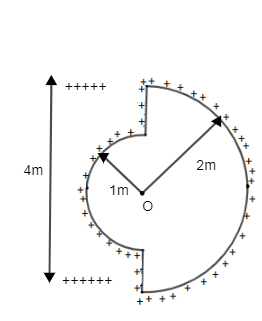
If the $\lambda =1\mu C/m,$ then electric field intensity at O is:

$\begin{align}
& A.\text{ }9N/C \\
& B.\text{ }900N/C \\
& C.\text{ }9000N/C \\
& D.\text{ }9\times {{10}^{9}}N/C \\
\end{align}$

Answer
556.2k+ views
Hint: In order to find the solution of this equation we will use the formula related linear charge density ($\lambda $) and the electric field density and that is $E=\dfrac{2k\lambda }{r}$ by using this equation we will get electric field intensity at point o.
Formula used:
$E=\dfrac{2k\lambda }{r}$
E = electric field intensity
$\lambda $= linear charge density
r = distance r from the line
Complete step-by-step answer:
Now it is given that in the question that the value of the linear charge density is
$\lambda =1\mu C/m$
$\to $ So if we convert from $\mu C/m$ to C/m we have to multiply by ${{10}^{-6}}$ now the value of the linear charge density is
$\lambda =1\times {{10}^{-6}}C/m$

$\to $Now the electric field intensity at the distance from 1m is given by
${{E}_{1}}=\dfrac{2k\lambda }{r}$
Here the value of k is given by $9\times {{10}^{9}}$
$\begin{align}
& {{E}_{1}}=\underset{1}{\mathop{2\times 9\times {{10}^{9}}\times 1\times {{10}^{-6}}}}\, \\
& {{E}_{1}}=18\times {{10}^{3}}N/C......\left( 1 \right) \\
\end{align}$
$\to $Now the electric field intensity at distance from 2m is given by
$\begin{align}
& {{E}_{1}}=\underset{2}{\mathop{2\times 9\times {{10}^{9}}\times 1\times {{10}^{-6}}}}\, \\
& {{E}_{1}}=9\times {{10}^{3}}N/C......\left( 2 \right) \\
\end{align}$
$\to $Now the total electric field intensity at point o is given by
$E={{E}_{1}}-{{E}_{2}}......\left( 3 \right)$
$\to $Now substitute the value of the equation (1) and (2) in equation (3) to get electric field intensity at point o.
$\begin{align}
& E=18\times {{10}^{3}}-9\times {{10}^{3}} \\
& =\left( 18-9 \right)\times {{10}^{3}} \\
& =9\times {{10}^{3}}N/C \\
& E=9000N/C \\
\end{align}$
Hence the correct option is (C) 9000N/C
So, the correct answer is “Option C”.
Additional Information: In this question value of the k is given by $\dfrac{1}{4\pi {{\varepsilon }_{0}}}$ because the initial equation of the electric field intensity is
$E=\dfrac{\lambda }{2\pi {{\varepsilon }_{0}}r}$
Then we can substitute$\dfrac{1}{2\pi {{\varepsilon }_{0}}}$ by
$\begin{align}
& 2k=2\left( \dfrac{1}{4\pi {{\varepsilon }_{0}}} \right) \\
& 2k=\dfrac{1}{2\pi {{\varepsilon }_{0}}} \\
\end{align}$
Hence our equation will become
$E=\dfrac{2k\lambda }{r}$
Hence the correct option is (C).
Note: As shown in the figure that when the positive (+ve) charge is considered at a point o then from the both the sides the linear charge density will be opposite from the both the sides at the point o.
Formula used:
$E=\dfrac{2k\lambda }{r}$
E = electric field intensity
$\lambda $= linear charge density
r = distance r from the line
Complete step-by-step answer:
Now it is given that in the question that the value of the linear charge density is
$\lambda =1\mu C/m$
$\to $ So if we convert from $\mu C/m$ to C/m we have to multiply by ${{10}^{-6}}$ now the value of the linear charge density is
$\lambda =1\times {{10}^{-6}}C/m$

$\to $Now the electric field intensity at the distance from 1m is given by
${{E}_{1}}=\dfrac{2k\lambda }{r}$
Here the value of k is given by $9\times {{10}^{9}}$
$\begin{align}
& {{E}_{1}}=\underset{1}{\mathop{2\times 9\times {{10}^{9}}\times 1\times {{10}^{-6}}}}\, \\
& {{E}_{1}}=18\times {{10}^{3}}N/C......\left( 1 \right) \\
\end{align}$
$\to $Now the electric field intensity at distance from 2m is given by
$\begin{align}
& {{E}_{1}}=\underset{2}{\mathop{2\times 9\times {{10}^{9}}\times 1\times {{10}^{-6}}}}\, \\
& {{E}_{1}}=9\times {{10}^{3}}N/C......\left( 2 \right) \\
\end{align}$
$\to $Now the total electric field intensity at point o is given by
$E={{E}_{1}}-{{E}_{2}}......\left( 3 \right)$
$\to $Now substitute the value of the equation (1) and (2) in equation (3) to get electric field intensity at point o.
$\begin{align}
& E=18\times {{10}^{3}}-9\times {{10}^{3}} \\
& =\left( 18-9 \right)\times {{10}^{3}} \\
& =9\times {{10}^{3}}N/C \\
& E=9000N/C \\
\end{align}$
Hence the correct option is (C) 9000N/C
So, the correct answer is “Option C”.
Additional Information: In this question value of the k is given by $\dfrac{1}{4\pi {{\varepsilon }_{0}}}$ because the initial equation of the electric field intensity is
$E=\dfrac{\lambda }{2\pi {{\varepsilon }_{0}}r}$
Then we can substitute$\dfrac{1}{2\pi {{\varepsilon }_{0}}}$ by
$\begin{align}
& 2k=2\left( \dfrac{1}{4\pi {{\varepsilon }_{0}}} \right) \\
& 2k=\dfrac{1}{2\pi {{\varepsilon }_{0}}} \\
\end{align}$
Hence our equation will become
$E=\dfrac{2k\lambda }{r}$
Hence the correct option is (C).
Note: As shown in the figure that when the positive (+ve) charge is considered at a point o then from the both the sides the linear charge density will be opposite from the both the sides at the point o.
Recently Updated Pages
A man running at a speed 5 ms is viewed in the side class 12 physics CBSE

The number of solutions in x in 02pi for which sqrt class 12 maths CBSE

State and explain Hardy Weinbergs Principle class 12 biology CBSE

Write any two methods of preparation of phenol Give class 12 chemistry CBSE

Which of the following statements is wrong a Amnion class 12 biology CBSE

Differentiate between action potential and resting class 12 biology CBSE

Trending doubts
What are the major means of transport Explain each class 12 social science CBSE

Which are the Top 10 Largest Countries of the World?

Draw a labelled sketch of the human eye class 12 physics CBSE

How much time does it take to bleed after eating p class 12 biology CBSE

Explain sex determination in humans with line diag class 12 biology CBSE

Explain sex determination in humans with the help of class 12 biology CBSE




